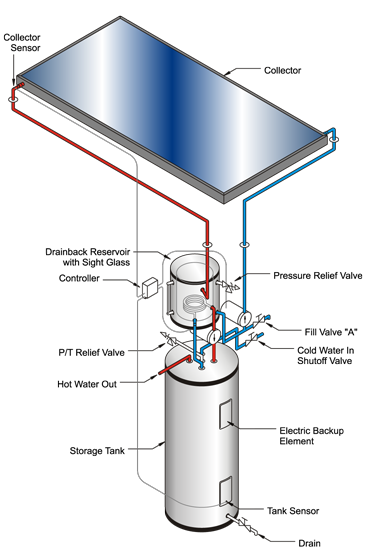
Hot Water. We all get into it some time. But a good source of hot water has become essential to civilized living, and can be produced in a variety of ways. The end result is usually the same but how you get there deals out some major pros and cons.
A conventional hot water heater is a great asset for a home or business, providing reliable hot water year round. Though the modern hot water heater by itself is a rather inefficient device and are expensive to operate. Many are produced with poor insulation and the general design often lend itself to a great annual loss of energy. An average household will often spend upwards of thirty to forty percent of their annual energy usage on supplying themselves with hot water. By utilizing some ancient technologies along with a little modern scientific know how, we can drop that usage down as much as fifty percent. Hot water is an excellent choice to begin with when addressing energy independence.
Solar Hot Water
Every year thousands of dollars worth of energy is rained down upon your rooftop. Most is wasted on creating a hot attic. Solar thermal collectors allow us to capture and harness that energy and put it to good use. If you own your own house and use hot water then you pay the utility company every month for the energy to heat your water. As the years go by you will have paid for a solar thermal system many times over. Owning your own system enables you to harvest your own energy, saving you hundreds of dollars per year and thousands over a lifetime. Solar hot water systems will integrate with your existing system, allowing it to collect free, abundant, and reliable energy for a lifetime.
Read on to learn more, or take a look at our packages.
How It Works
As the sun rises over the local hills, heat is collected by mounted solar panels. A water-glycol mix, acting as a heat transfer fluid, flows through copper tubes within the solar collectors. Once heated, the fluid exits the collector and circulates down to a storage reservoir. Heat is transferred by a heat exchanger within the reservoir to the potable domestic hot water, and then to a storage tank. This storage tank can be outfitted with an electrical element for backup during inclement weather, ready for use at anytime. If your existing hot water heater still has some good years left in it, you can extend its life using your solar water as a prefeed; your existing hot water tank, now serving as a backup heating system.
It is not uncommon for this solar-heated fluid to reach over 120°F on average days. While systems can be designed to produce steam if need be it is most cost effective to design a system that operates between 100° and 150° F year round. Of course one can always rely on conventional power, when available, to make up for and maintain any target range. Ensuring reliable heat year round and in any condition.

Diagram courtesy of AET
For more in-depth and technical information check out our PDF Library.
![]()
Savings
Water heating typically accounts for 25%-40% of your home's utility costs. Your system will be sized to deliver 100% of your hot water needs during summer months, and a resulting 50% during winter months, averaging 60-85% annually in our local conditions.
If you Have any more questions on the topic here is an excellent synopsis on Wikipedia.
